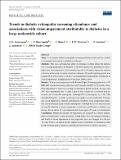Files in this item
Trends in diabetic retinopathy screening attendance and associations with vision impairment attributable to diabetes in a large nationwide cohort
Item metadata
| dc.contributor.author | Lawrenson, J. G. | |
| dc.contributor.author | Bourmpaki, E. | |
| dc.contributor.author | Bunce, C. | |
| dc.contributor.author | Stratton, I. M. | |
| dc.contributor.author | Gardner, P. | |
| dc.contributor.author | Anderson, J. | |
| dc.contributor.author | EROS Study Group | |
| dc.date.accessioned | 2021-04-15T10:30:11Z | |
| dc.date.available | 2021-04-15T10:30:11Z | |
| dc.date.issued | 2021-04 | |
| dc.identifier | 272129011 | |
| dc.identifier | 237b54a7-a19a-4573-9c9d-2b19a6db8ff7 | |
| dc.identifier | 85097904457 | |
| dc.identifier | 33064854 | |
| dc.identifier.citation | Lawrenson , J G , Bourmpaki , E , Bunce , C , Stratton , I M , Gardner , P , Anderson , J & EROS Study Group 2021 , ' Trends in diabetic retinopathy screening attendance and associations with vision impairment attributable to diabetes in a large nationwide cohort ' , Diabetic Medicine , vol. 38 , no. 4 , e14425 . https://doi.org/10.1111/dme.14425 | en |
| dc.identifier.issn | 0742-3071 | |
| dc.identifier.other | ORCID: /0000-0002-9478-738X/work/92371899 | |
| dc.identifier.uri | https://hdl.handle.net/10023/23034 | |
| dc.description.abstract | Aims: To investigate diabetic retinopathy screening attendance and trends in certified vision impairment caused by diabetic eye disease. Methods: This was a retrospective study of attendance in three urban UK diabetic eye screening programmes in England. A survival analysis was performed to investigate time from diagnosis to first screen by age and sex. Logistic regression analysis of factors influencing screening attendance during a 15-month reporting period was conducted, as well as analysis of new vision impairment certifications (Certificate of Vision Impairment) in England and Wales from 2009 to 2019. Results: Of those newly registered in the Routine Digital Screening pathway (n = 97 048), 80% attended screening within the first 12 months and 88% by 36 months. Time from registration to first eye screening was longer for people aged 18–34 years, and 20% were unscreened after 3 years. Delay in first screen was associated with increased risk of referable retinopathy. Although 95% of participants (n = 291 296) attended during the 15-month reporting period, uptake varied considerably. Younger age, social deprivation, ethnicity and duration of diabetes were independent predictors of non-attendance and referable retinopathy. Although the last 10 years has seen an overall reduction in vision impairment certification attributable to diabetic eye disease, the incidence of vision impairment in those aged <35 years was unchanged. Conclusions: Whilst the majority of participants are screened in a timely manner, there is considerable variation in uptake. Young adults, have sub-optimal attendance, and levels of vision impairment in this population have not changed over the last 10 years. There is an urgent need to explore barriers to/enablers of attendance in this group to inform policy initiatives and tailored interventions to address this issue. | |
| dc.format.extent | 11 | |
| dc.format.extent | 523790 | |
| dc.language.iso | eng | |
| dc.relation.ispartof | Diabetic Medicine | en |
| dc.subject | RA0421 Public health. Hygiene. Preventive Medicine | en |
| dc.subject | RC Internal medicine | en |
| dc.subject | Endocrinology | en |
| dc.subject | Endocrinology, Diabetes and Metabolism | en |
| dc.subject | Internal Medicine | en |
| dc.subject | 3rd-DAS | en |
| dc.subject | SDG 3 - Good Health and Well-being | en |
| dc.subject.lcc | RA0421 | en |
| dc.subject.lcc | RC | en |
| dc.title | Trends in diabetic retinopathy screening attendance and associations with vision impairment attributable to diabetes in a large nationwide cohort | en |
| dc.type | Journal article | en |
| dc.contributor.institution | University of St Andrews. School of Medicine | en |
| dc.contributor.institution | University of St Andrews. Population and Behavioural Science Division | en |
| dc.identifier.doi | 10.1111/dme.14425 | |
| dc.description.status | Peer reviewed | en |
This item appears in the following Collection(s)
Items in the St Andrews Research Repository are protected by copyright, with all rights reserved, unless otherwise indicated.

